How to Plant Rambutan From Seeds: A Beginner’s Guide
- April 2, 2024
- 1 comment
Discover how to plant Rambutan from seeds, a tasty tropical fruit from Southeast Asia. This step-by-step guide offers everything you need to know to grow a Rambutan tree, making it a rewarding project for gardeners.

Benefits of Rambutan
| Benefit | Description |
|---|---|
| Rich in Vitamin C | Rambutan is an excellent source of Vitamin C, which is crucial for immune system function and skin health. |
| Antioxidant Properties | Contains antioxidants like flavonoids, which help in fighting free radicals in the body, reducing the risk of chronic diseases. |
| Fiber Content | High in dietary fiber, which aids in digestion and helps in maintaining a healthy gut. |
| Iron Source | Provides iron, which is essential for forming red blood cells and transporting oxygen throughout the body. |
| Energy Boosting | Rambutan is a good source of carbohydrates and natural sugars, providing a quick energy boost. |
| Skin Hydration | The water content in Rambutan helps in keeping the skin hydrated and supple. |
| Low in Calories | A low-calorie fruit, making it a healthy snack for those managing their weight. |
| Promotes Heart Health | The potassium in Rambutan helps regulate blood pressure, contributing to heart health. |
| Improves Bone Health | Contains calcium and phosphorus, minerals that are vital for strong bones and teeth. |
| Supports Metabolism | Presence of various vitamins and minerals aids in enhancing metabolic processes in the body. |
Seed Selection and Preparation
Seed Selection
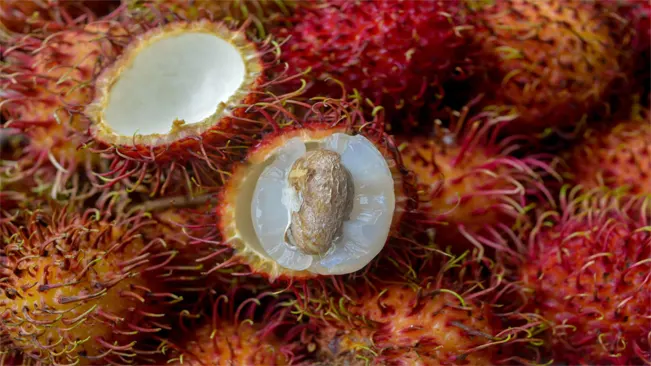
- Why Choose Ripe Fruits: The seeds from ripe Rambutan fruits have the highest germination potential. Ripe fruits are usually bright red or yellow and feel slightly soft to the touch. The color and texture indicate that the fruit, and consequently the seed inside, has reached full maturity.
- Freshness is Key: Seeds should be sown as soon as possible after extraction from the fruit. The longer a seed is left out, the more its viability decreases. Rambutan seeds are known to lose their germination ability quickly when dried or exposed to the air for extended periods.
Seed Preparation
Removing the Seed

- Extracting the seed from the fruit pulp needs to be done with care. Cut into the fruit and gently pull it apart, ensuring not to damage the seed inside. It’s important to handle the seed gently to avoid bruising or cutting it, as any damage can impact germination.
Cleaning the Seed
- Rambutan seeds are often covered with a sticky residue from the fruit’s flesh. Rinsing them under running water will help remove this residue. Clean seeds are less likely to develop mold or fungus during the germination process.
Soaking the Seed
- Soaking the seed in lukewarm water serves multiple purposes. It helps to soften the outer layer of the seed, making it easier for the seedling to break through during germination. This process also mimics the natural humidity and moisture levels that the seed would experience in its native tropical environment. Soaking for about 24 hours is usually sufficient.
Germination Process
Rambutan seeds, like many tropical fruit seeds, are sensitive to their growing conditions, especially during the crucial germination phase. To successfully germinate these seeds, it’s essential to replicate their natural, tropical environment as closely as possible.
Detailed Steps for Seed Germination
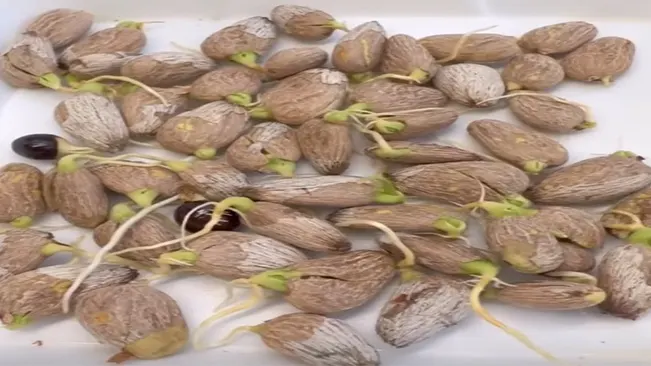
- Preparation of Growing Medium
- Start by filling a small pot with a well-draining soil mixture. This usually involves a combination of potting soil and compost. The compost adds nutrients while the potting soil ensures proper drainage. The soil should be loose and rich in organic matter, as this closely mimics the soil composition in Rambutan’s native habitat.
- Seed Planting
- Plant the Rambutan seed about 2-3 centimeters deep. It’s important to place the seed with the flatter side facing downward. This orientation helps the seed to anchor itself effectively, allowing the emerging root to penetrate the soil with ease.
- Watering Techniques
- Water the soil immediately after planting the seed to initiate the germination process. The soil should be kept consistently moist, but it’s crucial to avoid overwatering. Overwatered soil can lead to issues like root rot, which can be detrimental to the seedling. Aim for a balance where the soil feels damp to the touch but not soggy.
- Creating a Warm Environment
- Rambutan seeds need warmth to germinate, ideally around 30°C (86°F). If you live in a cooler climate, you can use a heat mat under the pot to maintain this temperature. Alternatively, placing the pot in a warm spot, like near a heater or a sunny window, can also help.
- Observing the Germination
- Germination usually takes place within 1-2 weeks, though it can sometimes take longer. You’ll notice the first sign of life when a small sprout emerges from the soil. This is a critical time for the seedling, as it begins to require more light.
- Sunlight Requirements
- Once the seedling appears, it needs ample sunlight for healthy growth. If you’re growing the seedling indoors, place it in a spot where it gets at least 6 hours of direct sunlight daily. If natural sunlight is insufficient, consider using grow lights to provide the necessary light spectrum.
Seedling Care
Sunlight
- Importance: Rambutan seedlings thrive in an environment with ample sunlight. Sunlight is crucial for photosynthesis, the process through which the plant generates its food.
- Tips for Adequate Sunlight:
- Place the seedling in a location where it can receive direct sunlight for at least 6 hours a day.
- If growing indoors, a south-facing window is usually ideal. You might also consider using grow lights to supplement natural light, especially in regions with less sunlight.
Watering
- Importance: Regular watering helps the seedling develop a strong root system, which is vital for nutrient absorption and overall growth.
- Watering Guidelines:
- The key is to maintain a balance – the soil should be moist but not waterlogged, as excessive water can lead to root rot.
- Water the plant when the top inch of soil feels dry. The frequency will vary depending on climate and season. In hot, dry weather, you might need to water more often.
- Employing a drip irrigation system or using a watering can with a long spout helps deliver water directly to the base without disturbing the young plant.
Fertilization
- Importance: Fertilizing is essential for providing additional nutrients that might not be sufficiently available in the soil.
- Fertilizer Application:
- Use a balanced, slow-release fertilizer that includes nitrogen, phosphorus, and potassium (often labeled as N-P-K on fertilizer packages).
- The frequency of fertilization can be every 2-3 months, but it’s important to follow the instructions on the fertilizer packaging.
- Over-fertilizing can be harmful, causing nutrient burn or imbalances in the soil.
Transplanting
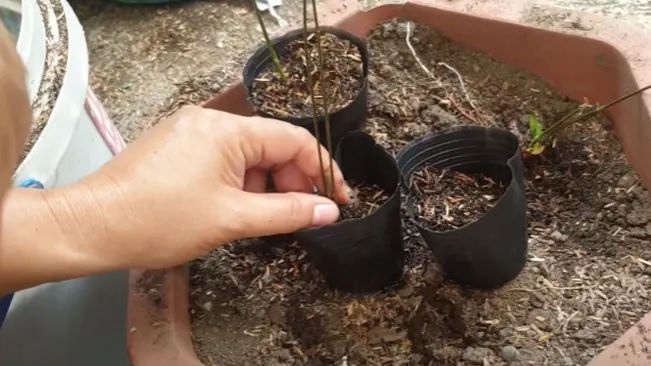
Choosing the Right Location
- Sunlight: Rambutan trees thrive in full sunlight. The chosen spot should receive at least six hours of direct sunlight per day.
- Soil Quality: Well-draining soil is essential to prevent waterlogging, which can cause root rot. Rambutan trees prefer slightly acidic soil with good fertility.
- Space: Consider the mature size of the Rambutan tree. Ensure there is ample space for the tree to grow, both above and below ground.
Preparing the Hole
- Size of the Hole: The hole should be dug twice as wide and twice as deep as the root ball of the seedling. This allows the roots to spread out easily.
- Soil Preparation: Before placing the seedling, you might want to amend the soil with compost or a balanced fertilizer to give the seedling a nutrient boost.
Transplanting the Seedling
- Handling the Seedling: Be gentle when removing the seedling from its current pot. Disturbing the roots as little as possible is key.
- Positioning: Place the seedling in the center of the hole. The top of the root ball should be level with the ground surface.
- Backfilling: Fill the hole with soil, gently tamping down to remove air pockets. Ensure the seedling is standing straight.
Ongoing Maintenance
Watering
Rambutan trees, like many tropical fruit trees, prefer a balance in soil moisture. They don’t do well in constantly soggy soil, but they also shouldn’t be allowed to dry out completely. The key is deep, infrequent watering.
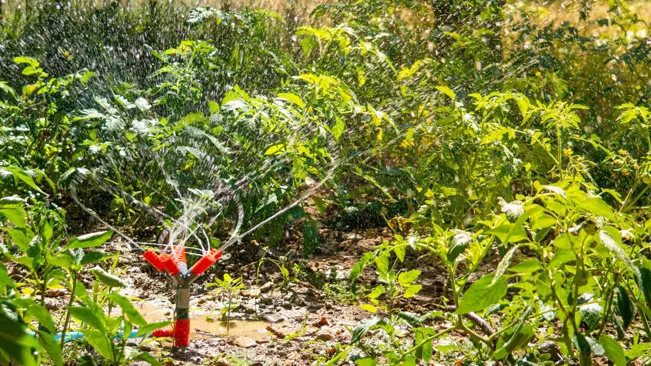
- How to Water: Water the tree deeply, ensuring that moisture reaches the deeper roots. Then, allow the top layer of soil to dry out before the next watering. This approach encourages the roots to grow deeper, seeking moisture and nutrients, which strengthens the tree.
- Frequency: This can vary depending on your climate and the season. In hotter, drier weather, you may need to water more frequently. In cooler or rainy seasons, less frequent watering is needed.
- Signs of Improper Watering: Overwatering can lead to root rot, while under-watering might cause the leaves to wilt or yellow.
Pruning
Pruning is crucial for maintaining the health and structure of your Rambutan tree.
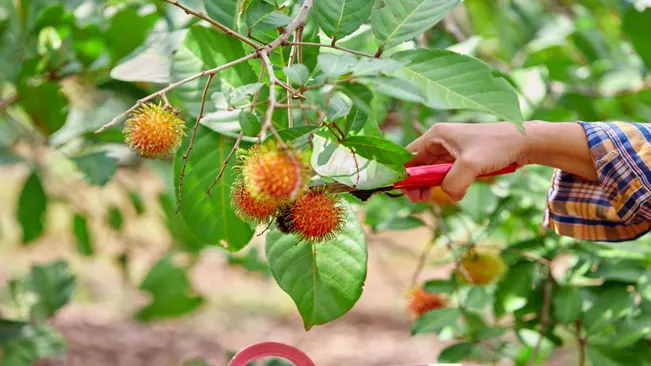
- When to Prune: The best time to prune is in late winter or early spring, before the new growth starts. However, you can remove dead or diseased branches at any time.
- How to Prune: Focus on removing any dead, damaged, or diseased branches. Also, trim the tree to encourage horizontal branching, which will help in fruit production. Keep the center of the tree open to allow sunlight and air to penetrate, which helps prevent disease.
- Regular Shaping: Regular shaping of the tree not only manages its size but also can influence fruit production. Proper pruning can stimulate growth in areas that will bear fruit.
Pest and Disease Management
Tropical fruit trees can be susceptible to various pests and diseases. Regular monitoring and proactive treatment are key.
- Common Pests: Look out for pests like aphids, mites, and mealybugs. Natural predators, like ladybugs, can be a great organic solution for controlling these pests.
- Disease Prevention: Fungal diseases can be an issue, especially in humid conditions. Ensuring good air circulation through pruning and proper spacing between trees can help. Also, avoid overhead watering to keep foliage dry.
- Treatment: Use appropriate fungicides or insecticides when necessary, considering organic options to keep your garden eco-friendly.
Patience and Harvesting
Rambutan trees may take several years to bear fruit. When the fruits turn a vivid red or yellow, they are ripe and ready to be harvested.
Time to Maturity
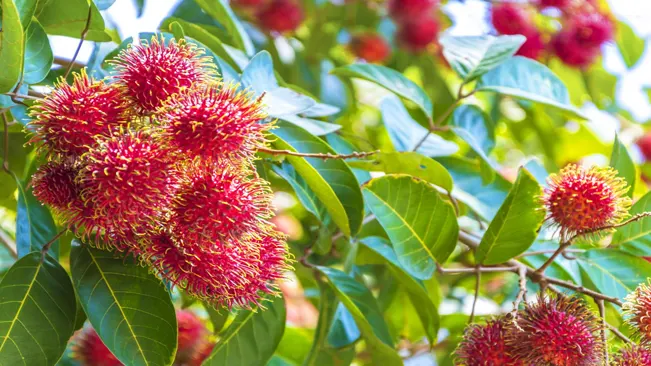
- Years to Bear Fruit: Rambutan trees, especially those grown from seed, typically take about 5 to 6 years to begin bearing fruit. In some cases, it may even take longer, depending on growing conditions and the specific variety of Rambutan.
Signs of Maturity
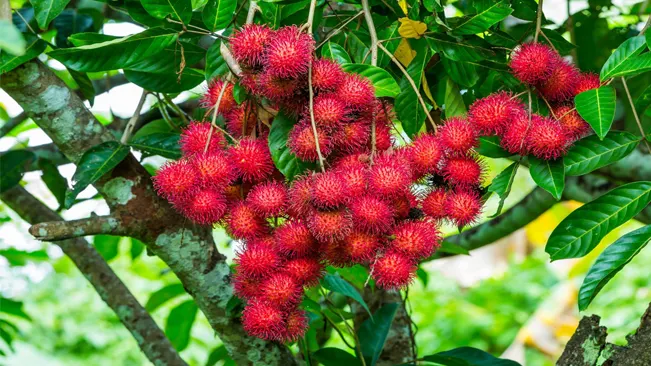
- Color Change: The most obvious sign that Rambutan fruits are ready to harvest is their color change. Rambutan fruits turn from green to a vivid red or yellow when they are ripe, depending on the variety.
- Texture: Ripe Rambutan fruits have a slightly soft but firm texture. The spines (or hairs) on the fruit also become more pliable when the fruit is ripe.
Harvesting
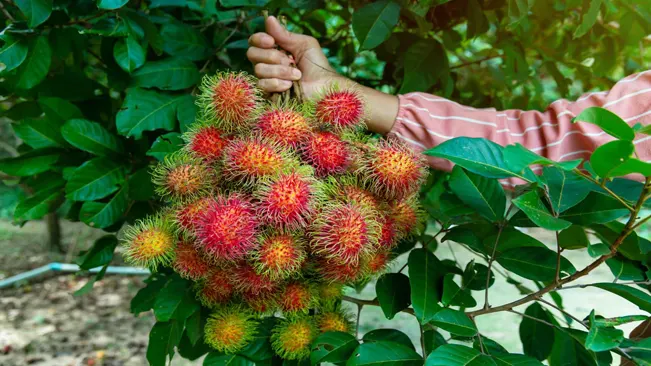
- Method: Fruits are typically handpicked. It’s important to gently twist or cut the fruit off to avoid damaging the branch or tree.
- Timing: Harvesting usually occurs once a year, and the timing can depend on the local climate and weather conditions. In some tropical regions, there may be more than one harvest season.
Post-Harvest
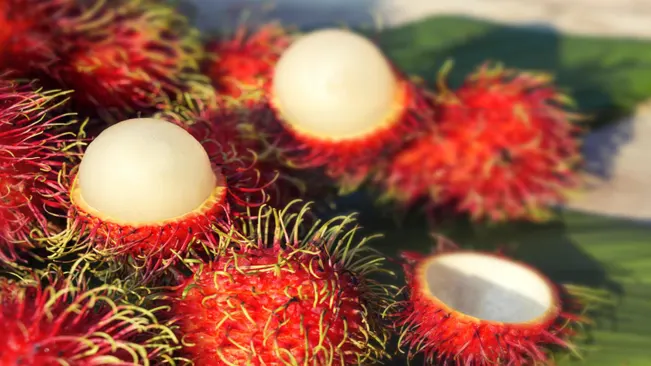
- Shelf Life: After harvesting, Rambutan fruits have a relatively short shelf life and are best consumed within a few days. Refrigeration can extend their freshness a little longer.
- Usage: Rambutan is commonly eaten fresh. The skin is peeled away to reveal the juicy, translucent flesh around the seed, which is the edible part of the fruit.
Conclusion
In conclusion, growing Rambutan from seed is a fulfilling process that requires patience, care, and a bit of tropical flair. With proper attention and nurturing, your Rambutan tree will reward you with delicious fruits for years to come. Happy gardening!
FAQs (Frequently Asked Questions)
- How do I select the right Rambutan seed for planting?
- Choose seeds from fresh, ripe Rambutan fruits. The fresher the seed, the better the chances of successful germination.
- Choose seeds from fresh, ripe Rambutan fruits. The fresher the seed, the better the chances of successful germination.
- Do Rambutan seeds need to be dried before planting?
- No, Rambutan seeds should be planted fresh. Drying them out can significantly decrease the germination rate.
- No, Rambutan seeds should be planted fresh. Drying them out can significantly decrease the germination rate.
- What type of soil is best for planting Rambutan seeds?
- Use a well-draining soil mix with a good amount of organic matter (like compost). The soil should be fertile and slightly acidic.
- Use a well-draining soil mix with a good amount of organic matter (like compost). The soil should be fertile and slightly acidic.
- How deep should I plant a Rambutan seed?
- Plant the seed about 2-3 centimeters deep in the soil.
- Plant the seed about 2-3 centimeters deep in the soil.
- What is the ideal temperature for germinating Rambutan seeds?
- The ideal temperature is around 30°C (86°F). Rambutan seeds require a warm, humid environment to germinate effectively.
- The ideal temperature is around 30°C (86°F). Rambutan seeds require a warm, humid environment to germinate effectively.
- How long does it take for a Rambutan seed to germinate?
- Typically, it takes about 1-2 weeks for a Rambutan seed to germinate, though it can sometimes take longer.
- Typically, it takes about 1-2 weeks for a Rambutan seed to germinate, though it can sometimes take longer.
- How much sunlight does a Rambutan seedling need?
- Once the seedling emerges, it should receive plenty of sunlight. Aim for at least 6 hours of direct sunlight daily.
- Once the seedling emerges, it should receive plenty of sunlight. Aim for at least 6 hours of direct sunlight daily.
- When should I transplant my Rambutan seedling?
- Transplant the seedling when it reaches about 30 cm (12 inches) in height or when it’s sturdy enough to handle the transfer.
- Transplant the seedling when it reaches about 30 cm (12 inches) in height or when it’s sturdy enough to handle the transfer.
- How often should I water a Rambutan plant?
- Water regularly to keep the soil moist but not waterlogged. Allow the soil to dry out slightly between waterings.
- Water regularly to keep the soil moist but not waterlogged. Allow the soil to dry out slightly between waterings.
- When can I expect fruit from my Rambutan tree?
- Rambutan trees grown from seed can take about 5-6 years to bear fruit. Patience is key, as is providing proper care and maintenance.

Kristine Moore
Forestry AuthorI'm Kristine Moore, a seasoned garden landscaping professional with over 30 years of experience. My extensive career has been dedicated to transforming outdoor spaces into stunning, sustainable landscapes. With a deep understanding of horticulture, design principles, and environmental stewardship, I have become a respected figure in the field, known for creating harmonious, visually appealing, and eco-friendly gardens. My commitment to excellence and continuous learning in landscaping trends and techniques has solidified my reputation as an expert in garden design and implementation.


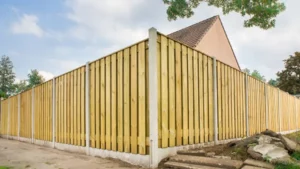
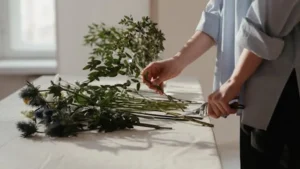


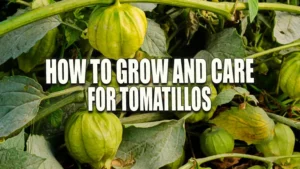




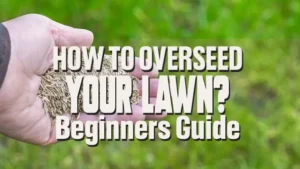

The article was useful and well explained thanks
Adele
July 13, 2024 8:51 pm